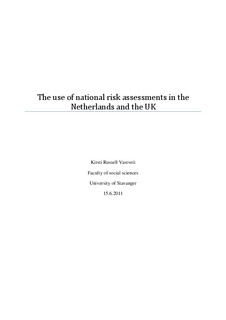| dc.contributor.author | Russell Vastveit, Kirsti | |
| dc.date.accessioned | 2011-12-01T16:46:06Z | |
| dc.date.available | 2011-12-01T16:46:06Z | |
| dc.date.issued | 2011 | |
| dc.identifier.uri | http://hdl.handle.net/11250/184618 | |
| dc.description | Master's thesis in Risk management and societal safety | no_NO |
| dc.description.abstract | The use of national risk assessments, a process used to assess the risks associated with large scale unwanted events that might cause disruption of entire states and their societies, is becoming increasingly popular among European countries. National risk assessments usually consist of several phases; scenario development, scenario analysis by experts, assessment by bureaucrats and compilation of a matrix depicting the scores of the scenarios in relation to each other in terms of probability and impact. They generally examine both intentional threats and accidents that might impact the functioning of infrastructure and society in general with nearly the same methodology; hence they may be described as using an all hazard approach.
Most of the writing on national risk assessments has focused on issues related to the methods; how likelihood and impact are scored as well as how these are combined to reflect a specific point in the risk matrix. The actual use and results of national risk assessments do not appear to have received similar attention, perhaps because they are still a relatively new phenomena. This is an interesting issue because actual use of risk assessments, even at lower levels of government in terms of informing and developing policy, appears to be challenging.
This dissertation therefore considers two main dimensions of use of national risk assessments;
1. What are the broad functions of national risk assessments for the actors that participate in or use it?
2. In terms of actual concrete policy making what are the type of projects that emanate from national risk assessments?
This dissertation explores the manner in which the Netherlands and the UK have undertaken use of their national risk assessment, what this says about the general functions these programs have, and the meanings attributed to the national risk assessments.
Rather than seeing the national risk assessments through the lens of and measuring them against a particular normative framework, this dissertation focuses on exploring how national risk assessments are used. This is done by focusing on developing an understanding of how the assessments are used based mainly on empirical evidence. To do this a grounded theory approach which asks the researcher to base the development of his or her understanding of phenomena on empirical data rather than pre constructed, theoretical frameworks, is be used. [...] | no_NO |
| dc.language.iso | eng | no_NO |
| dc.publisher | University of Stavanger, Norway | no_NO |
| dc.relation.ispartofseries | Masteroppgave/UIS-SV-IMKS/2011; | |
| dc.subject | samfunnssikkerhet | no_NO |
| dc.title | The use of national risk assessments in the Netherlands and the UK | no_NO |
| dc.type | Master thesis | no_NO |
| dc.subject.nsi | VDP::Social science: 200::Political science and organizational theory: 240 | no_NO |
